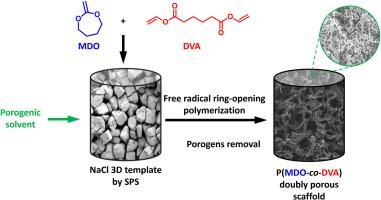Our official English website, www.x-mol.net, welcomes your
feedback! (Note: you will need to create a separate account there.)
Degradable biporous polymeric networks based on 2-methylene-1,3-dioxepane: Towards hierarchically structured materials meant for biomedical applications
Polymer ( IF 4.1 ) Pub Date : 2024-06-28 , DOI: 10.1016/j.polymer.2024.127332 Brian Barber Nunez , Yohann Guillaneuf , Daniel Grande , Benjamin Carbonnier , Benjamin Le Droumaguet
Polymer ( IF 4.1 ) Pub Date : 2024-06-28 , DOI: 10.1016/j.polymer.2024.127332 Brian Barber Nunez , Yohann Guillaneuf , Daniel Grande , Benjamin Carbonnier , Benjamin Le Droumaguet

|
For the first time, the preparation of doubly porous “poly(ε-caprolactone)-like” networks through free-radical ring-opening copolymerization of 2-methylene-1,3-dioxepane with divinyl adipate was achieved via a double porogen templating approach. This versatile strategy allowed for the formation of macropores of around 150 μm generated by removal of sieved and sintered NaCl particles in water, while smaller pores in the 1–10 μm range were created by phase separation during the copolymerization process through a syneresis mechanism in the presence of a porogenic solvent. The chemical nature of the as-obtained scaffolds was evidenced by Raman spectroscopy. The two distinct porosity levels could be examined by scanning electron microscopy and mercury intrusion porosimetry. The nature of the porogenic solvent as well as its volume proportion and the amount of crosslinking agent in the polymerization feed allowed for finely tuning the porous features of the micropores. The crucial role of the double porosity of such biporous scaffolds on their water uptake and mechanical properties under compression was assessed by comparing them with their monoporous analogues, while their degradability was investigated in different alkaline aqueous media. The double porosity enabled a synergistic effect regarding the water uptake of the resulting scaffolds when compared to their monoporous counterparts. Doubly porous polymeric materials with appropriate mechanical properties were obtained, possessing high compressibility and shape memory behavior upon consecutive compression cycles. Finally, these materials display degradation rates that could be controlled depending on medium pH.
中文翻译:

基于2-亚甲基-1,3-二氧杂环己烷的可降解双孔聚合物网络:面向生物医学应用的分层结构材料
首次通过双致孔剂模板方法通过2-亚甲基-1,3-二氧杂环己烷与己二酸二乙烯酯的自由基开环共聚制备双孔“聚(ε-己内酯)样”网络。这种多功能策略允许通过去除水中筛分和烧结的氯化钠颗粒而形成约 150 μm 的大孔,而 1-10 μm 范围内的较小孔是通过共聚过程中的脱水收缩机制通过相分离产生的。致孔溶剂的存在。拉曼光谱证明了所得支架的化学性质。两种不同的孔隙率水平可以通过扫描电子显微镜和压汞孔隙率测定法进行检查。致孔溶剂的性质及其体积比例和聚合原料中交联剂的量允许微调微孔的多孔特征。通过将这种双孔支架与单孔类似物进行比较,评估了这种双孔支架的双孔隙对其吸水率和压缩机械性能的关键作用,同时研究了它们在不同碱性水介质中的降解性。与单孔支架相比,双孔隙能够在所得支架的吸水性方面产生协同效应。获得了具有适当机械性能的双孔聚合物材料,在连续压缩循环后具有高压缩性和形状记忆行为。最后,这些材料的降解率可根据介质 pH 值进行控制。
更新日期:2024-06-28
中文翻译:

基于2-亚甲基-1,3-二氧杂环己烷的可降解双孔聚合物网络:面向生物医学应用的分层结构材料
首次通过双致孔剂模板方法通过2-亚甲基-1,3-二氧杂环己烷与己二酸二乙烯酯的自由基开环共聚制备双孔“聚(ε-己内酯)样”网络。这种多功能策略允许通过去除水中筛分和烧结的氯化钠颗粒而形成约 150 μm 的大孔,而 1-10 μm 范围内的较小孔是通过共聚过程中的脱水收缩机制通过相分离产生的。致孔溶剂的存在。拉曼光谱证明了所得支架的化学性质。两种不同的孔隙率水平可以通过扫描电子显微镜和压汞孔隙率测定法进行检查。致孔溶剂的性质及其体积比例和聚合原料中交联剂的量允许微调微孔的多孔特征。通过将这种双孔支架与单孔类似物进行比较,评估了这种双孔支架的双孔隙对其吸水率和压缩机械性能的关键作用,同时研究了它们在不同碱性水介质中的降解性。与单孔支架相比,双孔隙能够在所得支架的吸水性方面产生协同效应。获得了具有适当机械性能的双孔聚合物材料,在连续压缩循环后具有高压缩性和形状记忆行为。最后,这些材料的降解率可根据介质 pH 值进行控制。

















































 京公网安备 11010802027423号
京公网安备 11010802027423号